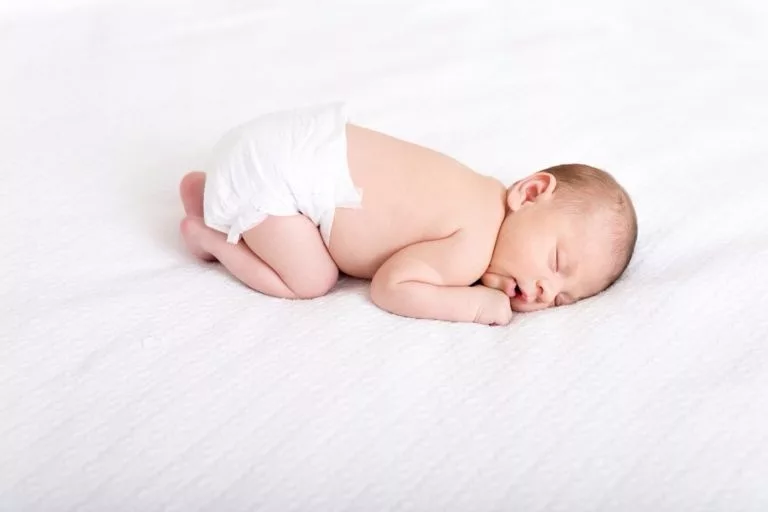If you’ve ever peeked into a crib or a toddler’s bed and found a baby sleeping with their tiny bottom sticking up in the air, you’re not alone in wondering why this happens. This adorable sleeping posture, often called the “froggy position”, is common among infants and young toddlers. While it might look unusual to adults, it’s a perfectly normal and natural part of a baby’s development.
This position is not only cute but also has deep connections to a baby’s physical growth, comfort, and instincts. Babies naturally adopt this posture for a variety of reasons, including muscle memory from the womb, developmental needs, and comfort. Let’s dive deeper into why babies sleep with their butt in the air and what it tells us about their bodies and behavior.
A Reminder of the Womb
The butt-in-the-air sleeping position is a strong reminder of the baby’s time in the womb. Inside the uterus, babies spend months curled up in the fetal position, with their knees tucked against their chest, their back rounded, and their body snugly compacted. This position is their first experience of comfort and security, and it remains ingrained in their muscle memory even after birth.
Newborns, in particular, are still adjusting to life outside the womb. The world can feel overwhelming compared to the tight, warm, and cozy environment they once knew. Sleeping with their legs tucked under their body and their bottom in the air helps recreate the sensation of being in the womb. It provides a sense of security and comfort that makes it easier for them to relax and fall asleep.
This behavior also highlights how instinctive and survival-oriented babies are. Their bodies naturally seek out positions and environments that feel safe. Over time, as they grow and adapt to their surroundings, they’ll begin to feel more comfortable stretching out in other sleeping positions. But in the early months, the froggy position offers a physical and emotional connection to the safety they experienced before birth.
Development of Core and Hip Muscles
Beyond being a source of comfort, the froggy position plays an important role in a baby’s physical development. During the day, as babies spend time on their tummies trying to crawl or scoot, they naturally keep their knees tucked under their body and their butt elevated. This posture helps strengthen the muscles in their core, hips, and legs—all of which are essential for achieving key developmental milestones like crawling, sitting, and eventually walking.
When babies sleep in this position, they are continuing to engage those same muscle groups. While it might not seem like active movement, the position provides gentle stretching and engagement for the muscles they rely on during the day. Think of it as their way of resting and recovering while staying ready for their next big move.
This position is particularly common in babies who are in the crawling stage. By tucking their knees under their body, they mimic the movements they use during crawling, which makes it easier for them to shift back into action when they wake up. It’s a functional position that supports their growing strength and mobility.
Flexibility and Bone Development
Babies are naturally more flexible than adults, thanks to their developing skeletal structure and soft, pliable joints. This flexibility allows them to sleep in positions that might seem awkward or uncomfortable to an adult. For example, the butt-in-the-air position takes advantage of their soft hip joints and malleable bones, enabling them to comfortably tuck their legs under their body.
At birth, a baby’s bones are still forming and hardening, a process known as ossification. The cartilage in their joints is softer and more elastic, which means that bending their legs under their body feels completely natural and doesn’t cause any strain. This is why many babies naturally gravitate toward positions like the froggy pose during sleep.
As babies grow and their skeletal system matures, they’ll gradually move away from this posture. Their hips will become less flexible, and their sleeping habits will shift toward more stretched-out positions. For now, though, their natural flexibility allows them to sleep comfortably in ways that promote both rest and development.
Comfort and Self-Soothing
The froggy position isn’t just about development—it’s also about comfort. Babies often find this position soothing because it allows their body to relax in a way that feels natural to them. The tucked-up posture may help relieve tension in their abdomen, which can be particularly beneficial for babies who experience gas or colic.
Additionally, sleeping with their butt in the air creates a cozy, grounded feeling. With their tummy resting against the mattress and their legs tucked under them, babies can feel stable and secure. This posture mimics the sensation of being cradled or swaddled, which is inherently calming for most infants.
For some babies, this position also acts as a form of self-soothing. It minimizes the chances of startling themselves awake with sudden movements, which can happen more frequently when they’re lying on their back with outstretched limbs. The froggy pose keeps their body compact and close, helping them feel more in control and less likely to wake up startled.
A Habit of Active Sleepers
Babies are naturally active sleepers, and their sleeping positions often reflect the developmental milestones they’re working on during the day. For babies who are learning to crawl, the froggy position is a direct extension of their daytime activities. By tucking their knees under their body and keeping their weight on their tummy, they’re practicing the movements they’ll use when crawling or transitioning to sitting.
This habit of bringing their daily movements into their sleep is part of how babies learn and grow. Sleep is a time for recovery, but it’s also a time when the brain processes and reinforces new skills. The butt-in-the-air position is just one example of how babies unconsciously practice what they’ve been working on while they’re awake.
As they become more mobile and start experimenting with standing and walking, you’ll likely notice their sleeping positions evolve as well. The froggy pose will give way to more stretched-out postures as they master new skills and their body adapts to these changes.
A Temporary Stage
The froggy sleeping position is most common in babies and young toddlers, typically up to around 12-18 months of age. As they grow older and their bodies develop, they naturally transition to other sleeping positions. By the time they’re confidently walking, most children will have moved on from the butt-in-the-air pose.
Parents should see this posture as a normal and healthy part of their baby’s development. While it might look unusual to us, it’s a completely natural stage that reflects their growth, instincts, and comfort. If your baby prefers this position, there’s no need to worry—it’s just one of the many adorable quirks of infancy.
That said, it’s still important to follow safe sleep guidelines, such as placing your baby on their back when you first put them to sleep. Once they’re old enough to roll over and adjust their own position, you can let them sleep however they’re most comfortable, including in the froggy pose.
Conclusion
Babies sleep with their butt in the air for a variety of reasons, all tied to their development, instincts, and comfort. This adorable position is a reminder of their time in the womb, supports the growth of their muscles and bones, and provides a cozy, soothing way for them to rest. It’s also a reflection of how babies integrate their daily movements and activities into their sleep, making it both a functional and endearing habit.
As your baby grows, this sleeping posture will naturally fade away, replaced by more mature and stretched-out positions. In the meantime, enjoy the sight of your little one snoozing in the froggy pose—it’s a fleeting but delightful part of early childhood that reflects the incredible adaptability and uniqueness of babies.




